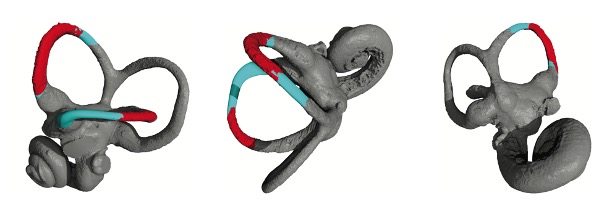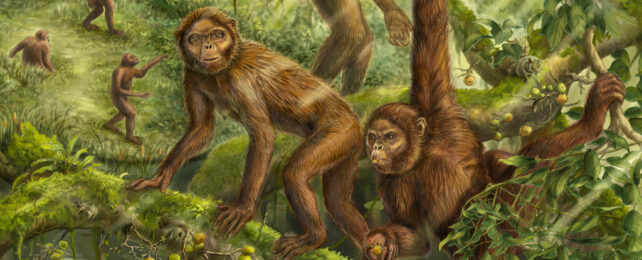From a four-limbed scramble to a two-legged amble – the knack for strutting our stuff on our hind limbs is one of the more obvious features distinguishing us humans and our ilk from great apes and earlier ancestors.
Unfortunately physical evidence of the transition is scarce. With so many possible ways the process could have taken place, it's hard to say with certainty how our anatomy and its mechanical functions evolved.
A new study of an ancient ape's inner ear suggests that the evolution of human bipedalism was not a sudden uprising, but a three-part process that bridged the gap between swinging in trees and standing on solid ground.
This new evidence comes from skulls of Lufengpithecus, an ape that lived in East Asia around 6 million years ago.
Some features of Lufengpithecus' teeth suggest it was a primitive ancestor of modern-day orangutans, which clamber about in tree canopies. However, other analyses of its skull place Lufengpithecus closer to African apes, such as gorillas and chimpanzees, known for their knuckle-walking.
This in-betweenness makes Lufengpithecus an interesting ape to study when the patchiness of the fossil record has meant scientists haven't been able to piece together the sequence of how early humans began to walk.
For their new study, Yinan Zhang, a paleontology doctoral student at the Chinese Academy of Sciences, and colleagues peered inside Lufengpithecus' ear, which might seem like an odd place to look for evidence of how a long-extinct creature moved.
Scientists have been clued into the vestibular system as a way to study how early humans and our relatives moved since at least 1994, when Dutch anatomist Fred Spoor and colleagues scanned the inner ear bones of more than 150 living and extinct primates.
The vestibular system of the inner ear, with its three, looping semicircular canals, sends information to the brain about an animal's position and motion in space. The canals are filled with fluid and fine hairs that sense movement, helping with balance.
"The size and shape of the semicircular canals correlate with how mammals, including apes and humans, move around their environment," explains Zhang, the first author of the study.

Zhang and colleagues digitally scanned three Lufengpithecus fossils excavated in southern China in the 1970s and 1980s, in which the bony labyrinths of the inner ear had been preserved when other parts of the skulls had been crushed.
The inner ear's bony labyrinth consists of three semicircular canals at one end, the spiral-shaped cochlea at the other, and the central vestibule in between.
"Using modern imaging technologies, we were able to visualize the internal structure of fossil skulls and study the anatomical details of the semicircular canals to reveal how extinct mammals moved," says Zhang.
Comparing the size and shape of Lufengpithecus' inner ear to those of extinct and living apes, including humans, and early human ancestors such as Australopithecus, the researchers were able to piece together a clearer picture of how early human ancestors began to walk.
"Our study points to a three-step evolution of human bipedalism," explains Terry Harrison, senior author of the study and New York University anthropologist.
Before Lufengpithecus, the earliest apes moved from branch to branch suspended by only their arms, like gibbons do today, Harrison says.
Then, Lufengpithecus emerged, representing an intermediary figure who climbed, clambered, and swung through trees while also moving about on four limbs on the ground, and using two limbs when holding onto branches.
The analysis suggests that Lufengpithecus closely resembled how the last common ancestor of apes and humans moved around, and it was from this mix of movements that human bipedalism eventually evolved.
That conclusion fits well with previous findings that have also suggested bipedalism emerged gradually, with ancestors holding themselves steady on trees and branches as they slowly found their feet.
"Even though humans generated bipedalism during their evolutionary history, we did come from a group of very unusual primates that developed unique ways of moving around their environment," Harrison told Laura Baisas at Popular Science. "So we are an oddity."
The study has been published in The Innovation.
